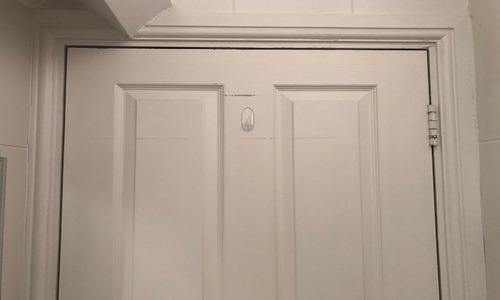In the bathroom or in the kitchen especially, mold can form in the unlikeliest of places such as on or around a door. Now that you’ve spotted mold in his unconventional spot, how do you remove the stuff? How can you ensure the mold doesn’t come back as well?
To remove mold from a door, you can use soap and vinegar that’s diluted with water. Distilled white vinegar and borax are heavier-duty but other suitable cleaners. Prevent mold recurrences by managing humidity and reducing clutter.
In today’s guide, we’ll explore your mold removal options. We’ll also discuss why mold forms on doors, the dangers of such, and prevention methods. Your home will be a lot safer by the time you’re done reading. So, to learn all about mold on doors, keep reading.

What Does Mold on a Door Look Like?
Doors come in an assortment of colors, and depending on yours, the presence of mold on the door can either be quite obvious or extremely difficult to see.
On this blog, we’ve made it quite clear that mold can appear in nearly as many colors as doors, from white to red, yellow, pink, orange, purple, brown, green, or black. Sometimes, mold is even several colors at once.
White, green, and black molds are common and thus the ones that you should be on the lookout for in your home.
If yours is a light-colored door such as a painted shade of white, then green or dark-colored mold will stand out like a sore thumb. White-colored mold might blend in unless inspecting the door closely.
Darker-colored doors such as natural wood can hide mold for a surprisingly long time, allowing it to propagate.
If you can’t determine from sight alone whether mold has spread across your door, you should be able to smell it if the mold problem is significant enough.
Mold has a musty and stale odor that’s very distinct.
What Causes Mold to Grow on Doors?
To you, a door may seem like such a strange location for mold to grow in your home. Why has this happened?
There are several reasons mold can develop on doors, so let’s go over them now.
Lack of Ventilation
In a very small room that lacks any form of ventilation, mold may appear on the door as well as possibly the walls and ceilings.
For example, if you have an additional bathroom upstairs without a window or any return vents, the heat in the room has nowhere to go, especially if the door remains closed.
You could spot mold on both sides of the door and its frame.
Humid Conditions
Speaking of the bathroom, in that space as well as in the kitchen, humidity is a frequent occurrence.
Whether it’s from boiling water, showering, cooking, or bathing, the humidity that develops must have a means of exiting.
If it doesn’t, then condensation can form on household surfaces.
Condensation, if it’s abundant enough, can warp wood, damage wallpaper, encourage materials to rot, and allow the home to become a rampant hotbed for mold and mildew.
Water Leaks
If the corner of your living room ceiling has been periodically dripping since the last major storm, this is no ignorable matter.
Not only can water leaks lead to expensive home damage in the thousands if not the tens of thousands of dollars, but in the interim, mold can freely grow.
Is Mold on a Door Dangerous?
Beyond the aesthetically displeasing effect of moldy doors in your home, is the issue also compounded by health risks?
Indeed, it is.
Mold in the house is in the air that you and your family breathe in.
Those with preexisting conditions such as asthma or a mold allergy may find that their symptoms are aggravated by the presence of the mold.
Even if you don’t have the above conditions, if you spend enough time in a moldy environment, you could begin developing adverse side effects such as coughing, congestion, itchy eyes, and headache.
It’s for everyone’s wellness that you treat mold on a door as soon as you see it.
Can Black Mold Grow on Doors?
As we established before, mold grows in its own unappealing rainbow, and that rainbow does include black.
Black mold is called toxic black mold, so its presence leaves homeowners with an even greater sense of unease, as it should.
Mold in any color should not be left to linger on doors, but that goes double for black mold. It can contribute to all the adverse health effects we outlined in the section prior.
How to Clean Mold from Doors
Removing mold from a door or its frame needn’t be challenging. You don’t want to reach for the heaviest-duty product right off the bat lest you damage the door frame material.
Thus, we’ll start with the tamest cleaning avenues and work our way up to those that may be harder on the door frame.
Soap and Vinegar
First, you can combine dish soap with vinegar and dilute it with water. Place the ingredients in a spray bottle and then coat the door or its frame.
Using a sponge or a rag, wipe the moldy area of the door.
If you’re not pleased with the results after a single application, feel free to repeat a second or third time.
Distilled White Vinegar
If you need a cleaner that’s moderately more heavy-duty, distilled white vinegar alone is a proven mold killer.
Don’t dilute the white vinegar, as you want it to work at its full effectiveness. Simply pour distilled white vinegar into a spray bottle and then mist the affected area of the door.
Allow an hour to pass and then use a moistened cloth to wipe away the vinegar residue. Pat the area dry with a towel when you’re finished.
Borax
If even distilled white vinegar didn’t put a dent in the mold on your door, then you should next try the alkaline mineral salt known as borax.
Borax is heavier-duty than even distilled white vinegar but isn’t as harsh as bleach, which you do not want to use. It’s not very effective on wood and will permanently stain your door or its frame.
Pour a cup of water into a shallow basin and then add a tablespoon of borax.
Take a soft-bristled brush, dip it into the mixture, and rub the brush on the moldy parts of your door.
Put some elbow grease into the scrubbing but don’t rub too hard. Try to use as little liquid as you can so you don’t soak the door.
Pat the area dry but do not rinse the borax away. You want it to continue working long after you applied it.
How to Prevent Mold from Growing on a Door
You’ve gladly ridden your door or frames of mold, but now you’re concerned about the fungi coming back. How do you prevent the redevelopment of mold on doors?
Here are some suggestions.
Keep Your Home Clean
Airflow is paramount in warding off mold. When you fill various rooms in your home with clutter, the air in the room has less space to move.
This can limit how well the air can travel, which can in turn potentially lead to mold if the conditions are warm and humid enough.
Watch Household Temperatures
The average home temperature should remain at 70 to 78 degrees Fahrenheit throughout the year.
Once you push your thermostat higher than that, the room could get too humid, and mold could potentially form around doors as well as on walls.
Address Water Damage Right Away
We must reiterate how serious water damage is in your home.
If you’ve had a bad storm that has caused water to leak from the ceiling, you need to call a plumber immediately.
The plumber can diagnose what has caused the leak and potentially repair it. If not, then they can put you in contact with a water damage remediation expert who can help.
Can Exterior Doors Develop Mold?
Throughout this article, we’ve discussed mold on doors and their frames as primarily an interior door problem.
Don’t be mistaken though. Mold can form on exterior doors just as much as on interior doors and possibly more often.
If the door is constantly exposed to water, then the moisture and warmth of the area, especially in those tight crevices you can’t reach, will encourage the spread of mold.
Conclusion
Mold on a door is an upsetting problem, as the mold looks unappealing and can exacerbate the health conditions of your family.
Prioritizing the removal of mold using common household products is the best course of action.
Remember, do not use bleach on interior or exterior door frames. Bleach is not very effective on wood and will stain your door frame for good.

